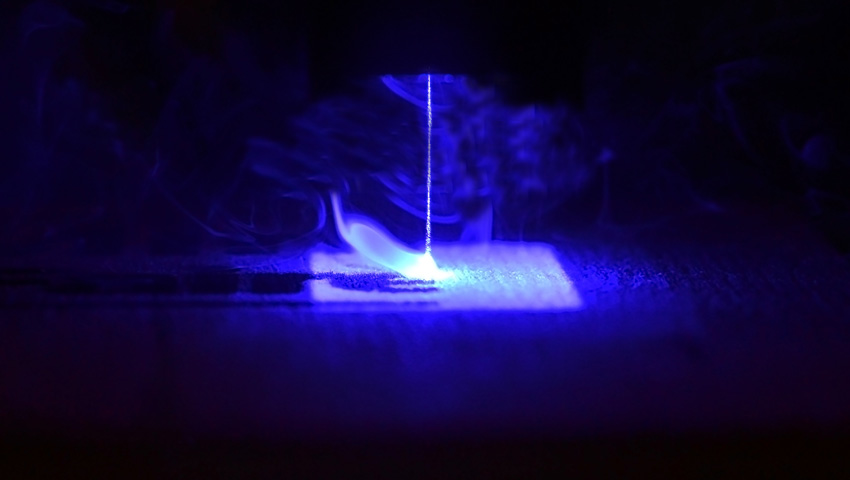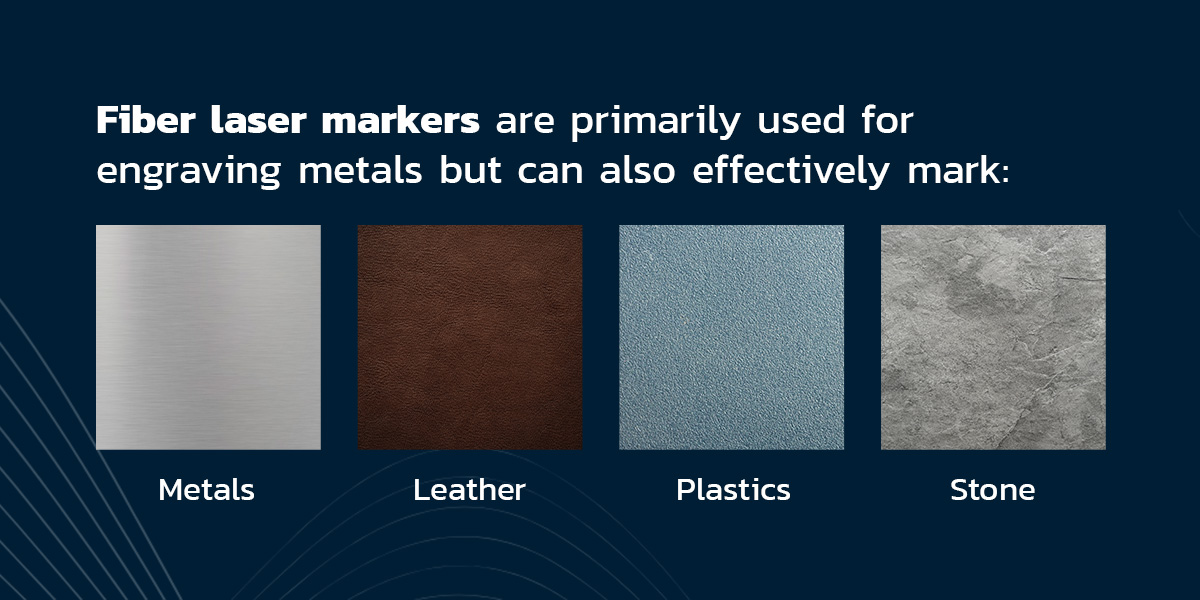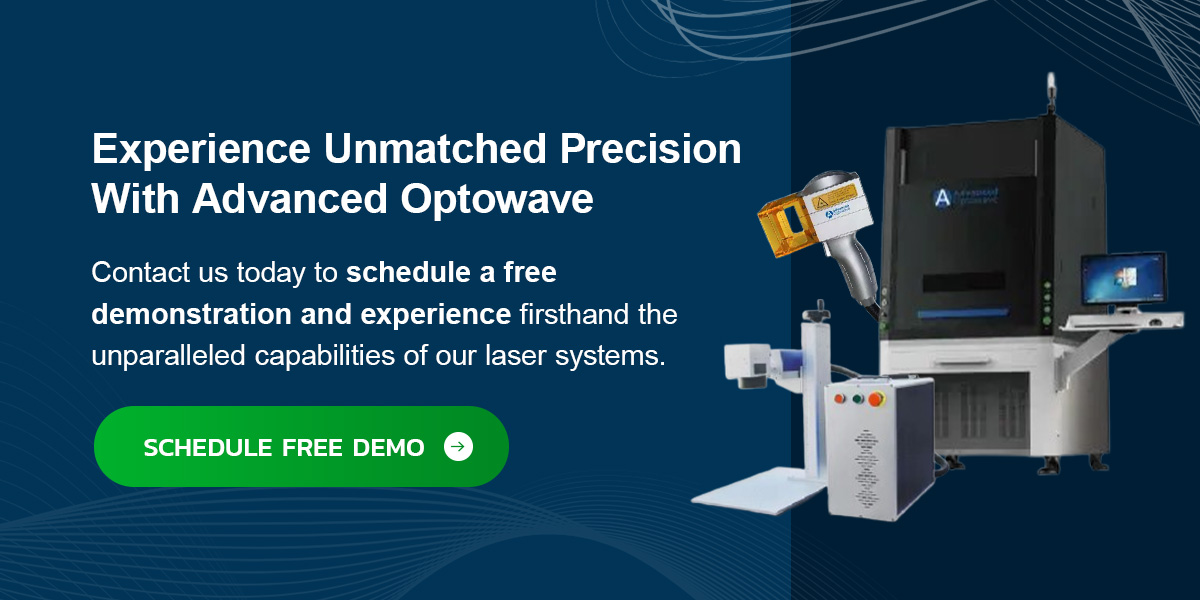

Laser marking is an efficient, lasting method for marking devices and materials. A laser marking machine uses an oscillator to emit a laser beam. A scanning mirror redirects the laser beam, and a focusing lens precisely places the beam on the material. Because laser marking uses light to create markings, it is highly resistant to wear and avoids fading like ink.
The best laser type for laser marking will depend on your material and industry. CO2, fiber and ultraviolet (UV) lasers are the three main laser types used in laser marking. Comparing fiber vs. CO2 vs. UV laser marking ensures operations obtain laser markers that deliver effective, accurate results for their work.
Most CO2 lasers operate at a standard 10.6 µm wavelength. These laser markers use a CO2 gas mixture inside a glass, ceramic or metal tube to produce marks.
During the marking process, CO2 and other gases like nitrogen and helium create a highly efficient laser when excited electrically. After entering an excited state, CO2 molecules return to their ground state and emit photons. The result is a highly concentrated light beam. Eventually, the amplified laser beam passes through a transparent mirror to the material.
These laser markers are versatile, coming in bench top or mark-on-the-fly options. They are used in industrial, hobbyist and high-cycle applications — their lower cost makes them an accessible tool for many users.
CO2 lasers are used in cutting, marking and engraving applications. Since they use heat to create the mark, they are ideal for organic cutting applications like glass, wood and cardboard. However, heat generated from the CO2 laser can damage more delicate materials. CO2 lasers can also be used to cut acrylics and plastic. CO2 lasers are often used in the woodworking, fabrication and garment industries to provide precise engravings on materials like acrylic, plastics and wood.
While CO2 lasers use the same principles to create the laser, there are three types of CO2 lasers — glass, metal and ceramic. These laser sources, or tubes, have different materials that affect how the gas mixture is retained.
Glass tubes conduct heat effectively, requiring constant cooling to avoid breaking. These CO2 laser markers use direct current (DC) to produce a larger laser beam and require the machine to move more slowly during marking and engraving to get a quality result.
Metal and ceramic source machines use radio frequency instead of DC voltage. This method gives the machine more precise engraving control, improved energy efficiency and a longer life. Ceramic and metal sources will produce a higher quality engraving result than glass — machines can quickly turn radio waves on and off, creating superior pulsation.
These are a few significant points to keep in mind regarding CO2 laser markers:
Fiber laser markers operate between 780 nm and 2200 nm. Their design and wavelength make them ideal for metal marking applications and some plastics. Working in the infrared range optimizes fiber laser markers for metals and engraving applications, but they cannot mark transparent materials.
Two of the main differences between CO2 and fiber lasers are the laser wavelength and size. Fiber lasers are highly precise and work at rapid speeds.


Fiber laser markers are primarily used for engraving metals but can also effectively mark metals, leather, plastics and stone. They are common in the aerospace, electronics, jewelry and automotive industries. While they can cut thin metals, fiber lasers’ high power and tight cycle times are best suited for engraving and marking.
The two main types of fiber laser markers are Q-switched markers and master oscillator power amplifiers (MOPA). Initially, Q-switched machines were the most common and less expensive than MOPA machines. However, Q-switched models provide less flexibility and efficiency, while MOPA lasers offer superior flexibility.
High-quality MOPA lasers come with a wide range of frequency adjustments and pulse widths, allowing them to minimize deformations and work with many materials. Single-emitter-pumping laser diodes in MOPA lasers also provide a lower heat density, increasing the machine’s life span.
Here are some advantages and considerations of fiber laser markers:
UV laser markers operate at a 355 nm wavelength. They use ultraviolet light to deliver exact, ultra-defined markings on materials. The UV laser’s wavelength is one-third the size of a standard laser’s wavelength, creating superior detail work during marking. A standard 1064 nm wavelength laser is passed through several nonlinear crystals to achieve this laser beam size. As the beam travels through each crystal, it decreases in size until it achieves the 355 nm wavelength.
With such a small beam, there is minimal heat stress on materials — this marking process using UV lasers is called “cold marking.” The UV light breaks the bonds between the material’s atoms and molecules, preventing the overheating seen with other laser markers.
UV laser markers have a high absorption rate across many common materials, including plastic and metals. This high absorption rate is one of the significant differences between CO2 and UV lasers. UV lasers require less power to produce their extremely controlled marks. With minimal heat-affected zones and precise capabilities, UV lasers are suited for marking almost all materials. Additionally, they can cut paper, PCBs and thin films. Their exceptional marking qualities make them popular in medical, military and aerospace operations.
UV laser markers offer several excellent benefits, though they have some drawbacks:
Elevate your manufacturing capabilities with the industry’s most advanced laser marking systems from Advanced Optowave Corporation. As a globally recognized leader in laser technology, we are Apple’s only approved UV laser vendor — a testament to our unmatched quality and innovation. Our CO2, fiber and UV laser markers are engineered to deliver exceptional precision, efficiency and longevity.
With over 55,000 laser systems installed worldwide, Advanced Optowave Corporation has earned the trust of leading brands across various sectors. Our comprehensive laser application solutions are designed to seamlessly integrate into your production process, ensuring superior performance and quality.
Contact us today to schedule a free demonstration and experience firsthand the unparalleled capabilities of our laser systems. Choose Advanced Optowave Corporation — where innovation meets precision.

